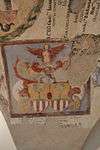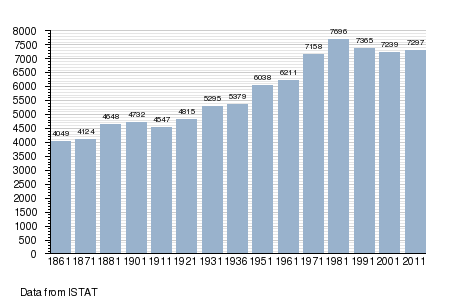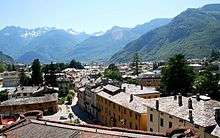Chiavenna
| Chiavenna | |
|---|---|
| Comune | |
| Città di Chiavenna | |
|
Townscape on the Mera | |
.svg.png) Chiavenna within the Province of Sondrio | |
 Chiavenna Location of Chiavenna in Italy | |
| Coordinates: 46°19′N 9°24′E / 46.317°N 9.400°ECoordinates: 46°19′N 9°24′E / 46.317°N 9.400°E | |
| Country | Italy |
| Region | Lombardy |
| Province / Metropolitan city | Province of Sondrio (SO) |
| Frazioni | Campedello, Loreto, Pianazzola, San Carlo |
| Area | |
| • Total | 11.1 km2 (4.3 sq mi) |
| Elevation | 333 m (1,093 ft) |
| Population (Dec. 2004) | |
| • Total | 7,263 |
| • Density | 650/km2 (1,700/sq mi) |
| Demonym(s) | Chiavennaschi |
| Time zone | CET (UTC+1) |
| • Summer (DST) | CEST (UTC+2) |
| Postal code | 23022 |
| Dialing code | 0343 |
| Website | Official website |
Chiavenna (Lombard: Ciavèna, Latin and Romansh: ![]() Clavenna or Claven, archaic German: Cläven or Kleven) is a comune (municipality) in the Province of Sondrio in the Italian region of Lombardy.[1] It is the centre of the Alpine Valchiavenna region. The historic town is a member of the Cittaslow movement.
Clavenna or Claven, archaic German: Cläven or Kleven) is a comune (municipality) in the Province of Sondrio in the Italian region of Lombardy.[1] It is the centre of the Alpine Valchiavenna region. The historic town is a member of the Cittaslow movement.
Geography
Chiavenna is located about 100 kilometres (62 mi) north of Milan and about 40 kilometres (25 mi) northwest of Sondrio. The town is situated on the right bank of the river Mera[1] about 16 kilometres (10 mi) north of Lake Como. The river course leads up to Val Bregaglia in the east and the Swiss border at Castasegna. In the north, the Valle Spluga stretches up to Passo dello Spluga and the road to Chur in the Grisons.
Chiavenna borders the following municipalities: Mese, Piuro, Prata Camportaccio, and San Giacomo Filippo.
The municipality of Chiavenna contains the frazioni (subdivisions, mainly villages and hamlets) Campedello, Loreto, Pianazzola, and San Carlo. As of 31 December 2004, it had a population of 7,263 and an area of 11.1 kilometres (6.9 mi).[2]
History

The name of Chiavenna, believed to derive by paretymology from clavis (English: key) referring to its pivotal position on the mountain passes between Northern Italy and the Posterior Rhine, comes in reality from a much older, pre-Latin (probably ligurian and certainly non-celtic) etymon klava, meaning fallen rocks of a mountain slip. In Roman times Clavenna was a town of Rhaetia, on the Italian side of the Alps, north of the head of the Lacus Larius (modern Lake Como), at the foot of the Valle Spluga. The itineraries demonstrate that Passo dello Spluga was frequented in ancient times; as well as another, which separated from it at Clavenna, and led by a more circuitous route over to Curia (modern Chur), where it rejoined the preceding road. (Itin. Ant. pp. 277, 278; Tab. Peut.; P. Diac. vi. 29.) It was by one or other of these passes that Stilicho crossed the Alps in midwinter, a feat celebrated by Claudian (de B. Get. 320–358).
After the collapse of the Western Roman Empire the city marked the northern limit of the Ostrogothic Kingdom in Italy. Clavenna was retaken by the Romans in the mid-6th century during the reign of Justinian and avoided capture by the Lombards until the 7th century. Clavenna probably derived some importance from its position at the junction of these two passes, as does the modern town of Chiavenna, which is the chief town of the surrounding district.
Chiavenna is crowned by a ruined castle, once an important strategic point, and the seat of the counts who ruled the valley from the time of the Goths till 1194, when the district was handed over to the bishops of Coire.[1]
Chiavenna received town privileges from the Bishops of Como. In medieval times, the castello served as a residence of local counts controlling the Alpine passes in the north and east. It was in Chiavenna, were the Hohenstaufen emperor Frederick Barbarossa met with his Welf cousin Henry the Lion and allegedly fell on his knees to implore Henry's aid against the cities of the Lombard League.
Initially under the overlordship of the Dukes of Swabia, the town was acquired by the Italian Visconti in the 14th century from the prince bishop of Chur. At a similar time to the transalpine campaigns of the Old Swiss Confederacy, it was controlled by the Three Leagues' forces.[3] This put the Valtellina (or Veltlin) back under the control of the Prince Bishop of Chur. The Three Leagues (modern The Grisons, German: Graubünden) was not part of Switzerland until Napoleon's much later conquest. To this day, there is a statue of Peter de Salis in Chiavenna, who was Anglo-Swiss, from the time when he was governor of the Valtellina. Hence, together with neighbouring Bormio and Valtellina it did not form part of the Old Swiss Confederacy, but was until 1797 when the French revolutionaries merged these valleys into the 1779 established Cisalpine Republic which was rapidly promoted to the Regno d'Italia with Eugène de Beauharnais as Viceré (the King being Napoleone Bonaparte himself).
After the fall of Napoleon, from 1815 to 1859 Chiavenna and the whole of Lombardy and Veneto went to the House of Habsburg, who always wanted control of the pass from Austria to Milan to link the Habsburg families. During the favourable time of the Regno Lombardo Veneto, primary schools were created in every place, and the instruction was made obligatory for maids. Lombard and Venetic women where the first to be alphabetised in Italy, long before the women of other Italian provinces. The Austrian administration build bold modern routes (Spluga, Stelvio), created hospitals and brought the level of medicine in Milan up to the top for the time. A citizen of Chiavenna could study in the universities of Innsbruck, Vienna, Prague, Budapest. He could serve in the imperial army, become an officer, accede to the higher administration, and be ennobled. After the proclamation of the Sabaudian Regno d'Italia, Chiavenna followed the sort of the rest of Lombardy.
Demographic evolution


Notable people
- Peter, (3rd) Count de Salis (1738–1807). A popular governor, 1771–1773 and 1781–1783.
References
- 1 2 3
 Chisholm, Hugh, ed. (1911). "Chiavenna". Encyclopædia Britannica. 6 (11th ed.). Cambridge University Press. p. 118.
Chisholm, Hugh, ed. (1911). "Chiavenna". Encyclopædia Britannica. 6 (11th ed.). Cambridge University Press. p. 118. - ↑ All demographics and other statistics: Italian statistical institute Istat.
- ↑ Friedrich Pieth (1945). Bündnergeschichte (in German). Chur, Siwtzerland: Schuler.
 This article incorporates text from a publication now in the public domain: Smith, William, ed. (1854–1857). "article name needed". Dictionary of Greek and Roman Geography. London: John Murray.
This article incorporates text from a publication now in the public domain: Smith, William, ed. (1854–1857). "article name needed". Dictionary of Greek and Roman Geography. London: John Murray.
External links
| Wikimedia Commons has media related to Chiavenna. |